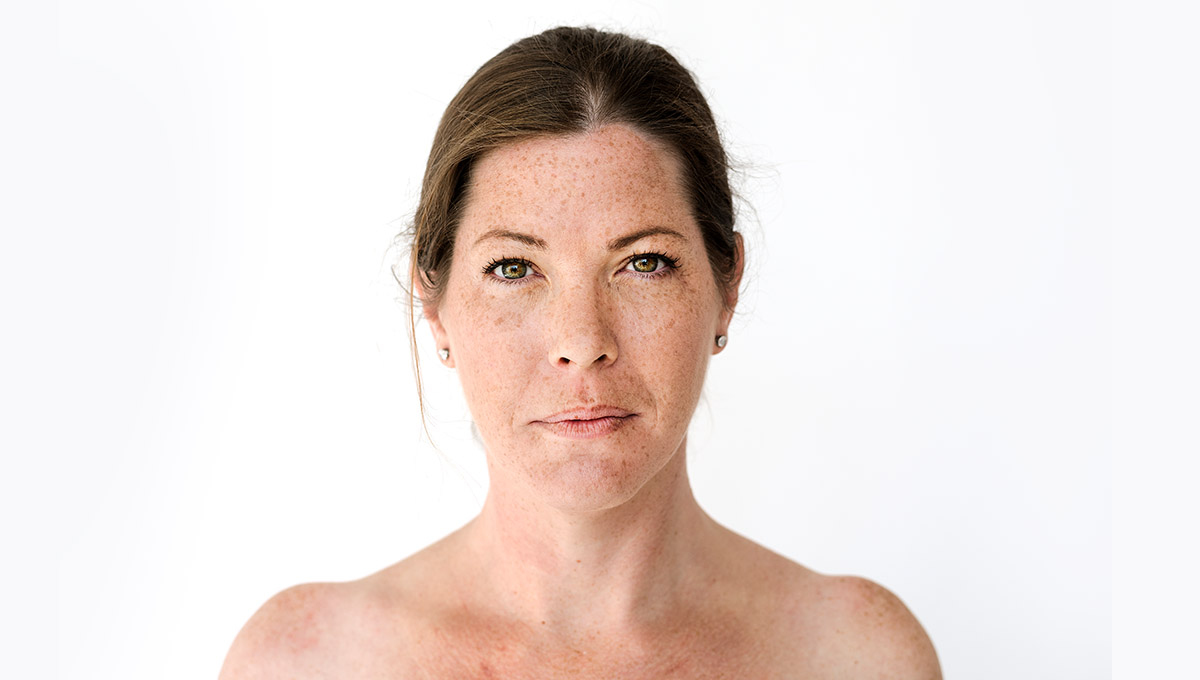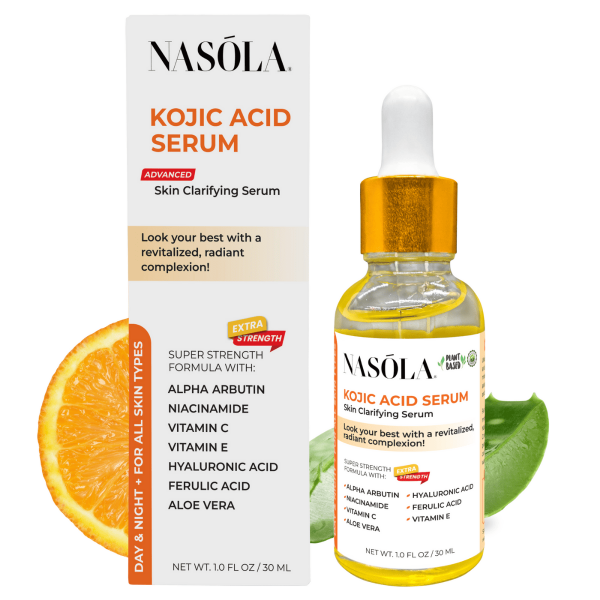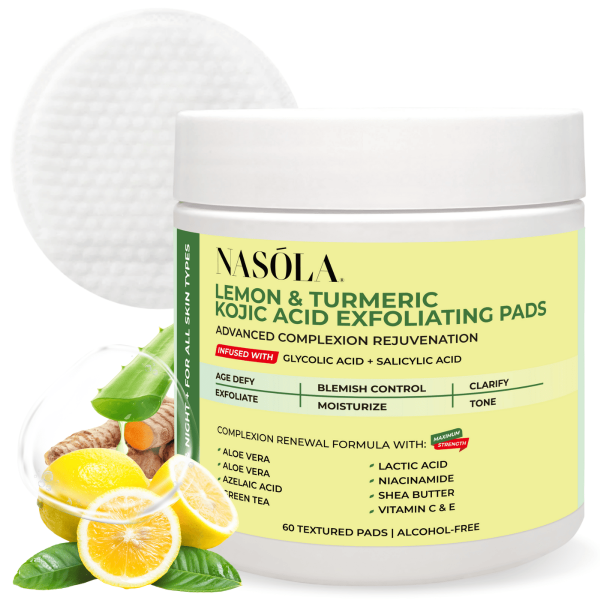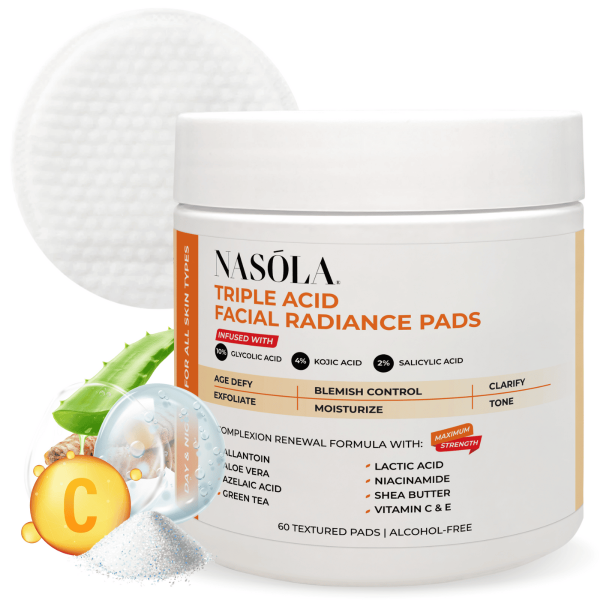Azelaic acid for melasma is finally taking its overdue spotlight as one of skincare’s safest and most effective tools to help smooth, brighten, and even out skin tone — without harsh effects.
If you’ve ever looked in the mirror and noticed those persistent brown patches, especially across your cheeks or upper lip… you’re not alone. Melasma affects millions, and it doesn’t care if you’re careful with your skincare or not.
I was a skeptic too, many years ago — battling flare-ups from sun exposure and hormonal shifts.
But the gentle power of azelaic acid paired with amazing products like the Nasola Kojic Acid Serum, Triple Acid Facial Radiance Pads, and Kojic Acid Toner turned everything around. This post will walk you through exactly why — and how — these work together.
- What is Melasma and How Does Azelaic Acid Work Against It?
- Azelaic Acid for Melasma Before and After
- Ingredient Spotlight: Kojic Acid
- Daily Skincare Routine with Azelaic Acid for Melasma
- How to Combine Other Products with Azelaic Acid Safely
- How to Identify and Avoid Melasma Triggers
- Customizing Your Skincare Timing for Faster Azelaic Acid Results
- Can You Use Azelaic Acid for Melasma Long-Term?
- Conclusion
- Frequently Asked Questions
What is Melasma and How Does Azelaic Acid Work Against It?

Melasma is more than just a cosmetic issue — it’s frustrating, stubborn, and deeply tied to internal changes. Especially for women, hormonal fluctuations due to pregnancy or birth control can trigger those tell-tale patches across the face.
Add in sun exposure — and BOOM. Hyperpigmentation settles in like an uninvited houseguest who overstays their welcome.
But azelaic acid?
It’s the quiet powerhouse that evens out skin tone, reduces inflammation, and stops pigment overproduction in its tracks. Azelaic acid for melasma works by inhibiting the enzyme tyrosinase, which your skin uses to produce melanin.
Less melanin = less pigmentation showing up on your skin.
Pair it with the Nasola Kojic Acid Serum, and now you’ve got kojic acid tagging in, also blocking melanin formation — a solid tag team that makes melasma gradually fade away. Together? A game-changer.
Understanding Melasma: The Mysterious Mask of the Face
Melasma has a knack for appearing on the cheeks, forehead, and above the upper lip — almost like a shadowy mustache that won’t budge. It’s usually symmetrical and more common in people with medium-to-dark complexions.
Why?
Because these skin types naturally produce more melanin, so when melanin goes into overdrive — it shows.
The big triggers?
- Hormonal changes (like pregnancy or oral contraceptive use)
- UV exposure (especially unprotected sun time)
- Heat and light from electronic screens (hello, Zoom calls)
- Genetic factors (if your mom had it, you might too)
The frustrating thing is: melasma doesn’t always fade on its own. That’s where azelaic acid steps in — gently but surely.
Mechanism of Action: How Azelaic Acid Fights Melasma
Unlike intense peels or lightening agents that can cause irritation or make things worse, azelaic acid works quietly — and effectively. Its three-pronged approach makes it ideal for stubborn melasma:
- Blocks melanin production by inhibiting tyrosinase
- Reduces inflammation often associated with pigmentation
- Boosts cellular turnover, gently speeding up the skin’s natural shedding process
Together, this calms down dark spots without triggering more sensitization. And when combined with something like the brightening Nasola Kojic Acid Serum? The changes can be incredible over time.
Azelaic Acid for Melasma Before and After
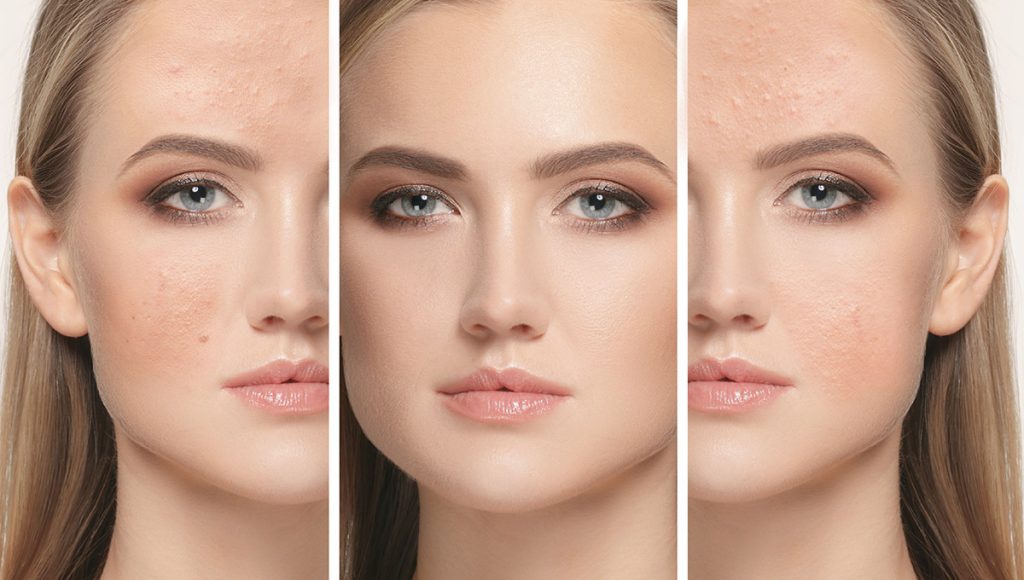
Results. That’s what most of us care about, right? Well — the azelaic acid for melasma before and after effects can be stunning. But you’ll need patience and a little consistency sprinkled in too.
Even though it’s gentle, azelaic acid works slow and steady, not overnight. Most people start noticing brighter, more even skin around weeks 4–6. With dedicated use, those dark marks slowly begin lifting, revealing your clearer skin underneath.
Products matter, too. Incorporating supplements like the Nasola Triple Acid Facial Radiance Pads boosts exfoliation, giving azelaic acid easier access to deeper layers.
Visual Transformation with Consistent Use
What does real progress look like?
- After 2 weeks: Skin feels smoother and less inflamed
- After 4–6 weeks: Pigmentation begins to fade
- After 2–3 months: More even tone, brighter complexion, fewer flare-ups
- After 6 months: Major reduction in pigmentation with regular use
And unlike harsher treatments, there’s no rebound hyperpigmentation — just steady improvement.
Realistic timelines?
That depends on your skin tone and severity, but on average, progress becomes noticeably visible by week 6.
Key Product to Enhance Results
For faster fade, the Nasola Triple Acid Facial Radiance Pads are a secret weapon. They combine glycolic, lactic, and salicylic acids to gently exfoliate, allowing azelaic acid to penetrate deeper.
Why are they magical?
- Support active exfoliation without irritation
- Help soften stubborn dark patches
- Smooth out rough texture, prepping skin for serums
- Calm blemishes while treating pigmentation
Use them every other night, and let the glow begin.
Customer Testimonial Snapshot
“I’ve tried everything for my melasma — NOTHING worked long term. I started using azelaic acid with Nasola’s Kojic Acid Serum and Triple Acid Pads in my routine for 2 months. Game. Changer. My upper lip marks from pregnancy have faded 80%. I feel like myself again.” — Alana S., 38, Dallas, TX
Ingredient Spotlight: Kojic Acid
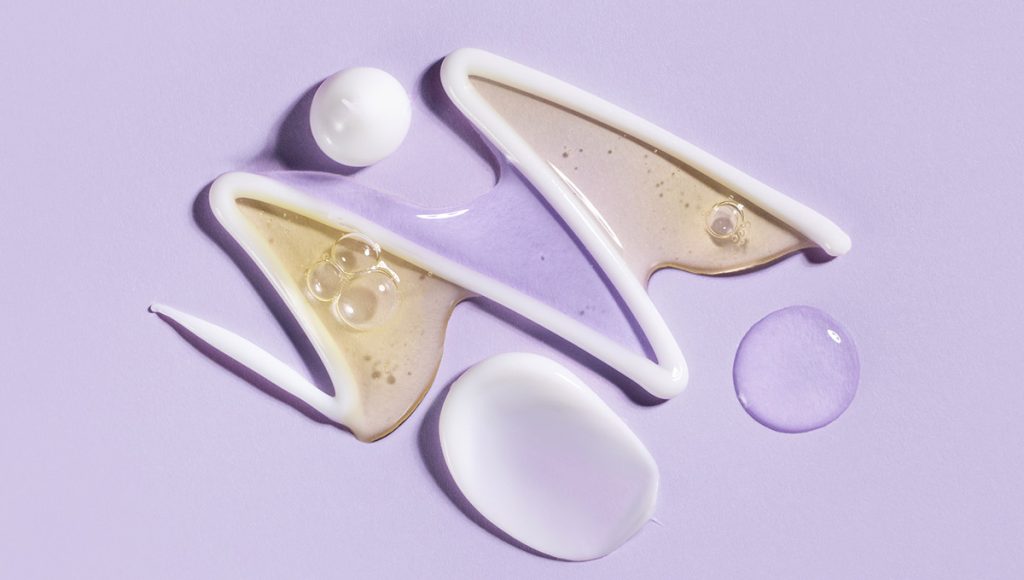
Let’s take a moment to appreciate kojic acid. Often overshadowed by stronger actives, it’s actually one of the most effective natural pigment inhibitors out there — and works beautifully with azelaic acid for melasma. No nonsense, just results.
Derived from fungi during fermentation, kojic acid blocks melanin formation at the source… and when paired with azelaic acid, it’s like flipping off the hyperpigmentation switch.
Say goodbye to shadow patches lingering longer than your last situationship 💁🏽♀️.
What is Kojic Acid and Why it Matters for Melasma?
Here’s the deal. Kojic acid:
- Reduces pigment by blocking tyrosinase
- Helps break down existing dark patches
- Evens out discoloration from acne scars and sun damage
- Has antibacterial and anti-inflammatory properties
Basically, it’s a gentle lightener with extra perks.
Boosting Brightening Results with Product Pairings
Let’s talk toner — because how you prep your skin matters. The Nasola Kojic Acid Facial Toner helps reset your skin’s pH and opens the pathway for azelaic acid to work its magic.
Why pair them?
- Toner preps skin for deeper product absorption
- Kojic acid reinforces pigment suppression
- Refreshes and hydrates without irritation
- Lightweight formula won’t clog pores or cause breakouts
Add 2-3 pumps into your morning and night routine, and witness the brightness unfold.
Daily Skincare Routine with Azelaic Acid for Melasma

Now that we’ve unpacked the ingredients, let’s build a routine that ACTUALLY helps.
Because consistency beats high-intensity anything when it comes to fading melasma.
Below is a simple AM/PM schedule incorporating Nasola essentials and azelaic acid:
Morning Routine
Start strong. Protect your progress.
- Cleanse your face with a mild soap-free gel
- Apply Nasola Kojic Acid Toner to refresh and prep skin
- Apply azelaic acid-based cream or serum in a thin layer
- Finish with broad-spectrum SPF 30+ (non-negotiable!)
In the morning, keeping it light and protective is key.
Evening Routine
Evening is when your skincare can really go to work:
- Cleanse thoroughly — remove all dirt, oils, and SPF
- Use Nasola Lemon Turmeric Kojic Acid Exfoliating Pads 2–3x a week (AHHH-mazing scent, BTW 👃🏽💛)
- Follow with your azelaic acid serum
- Moisturize with a calming, fragrance-free lotion
Stick to this, and check your reflection after a few weeks — it won’t lie.
How to Combine Other Products with Azelaic Acid Safely
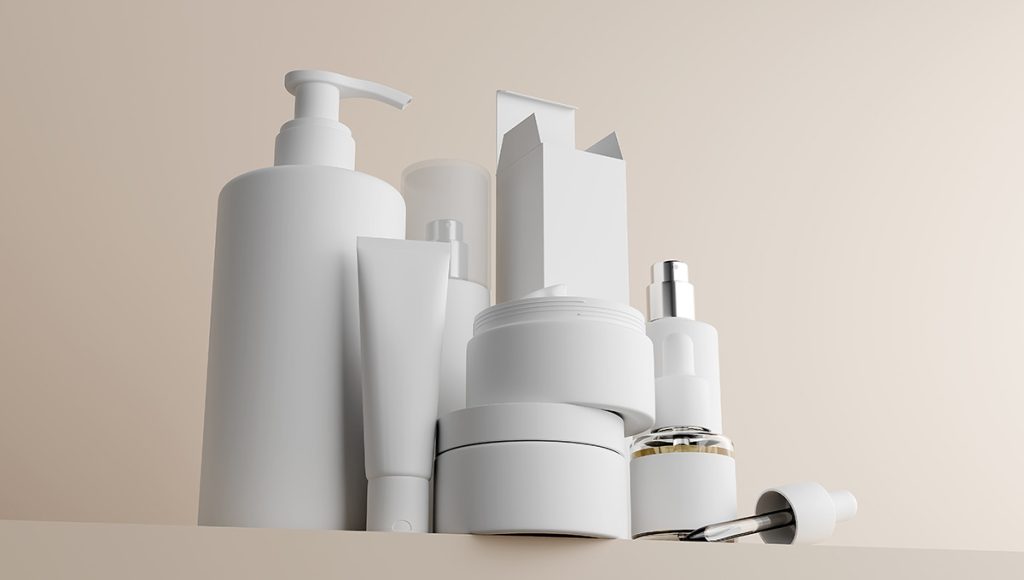
More isn’t always better. Overdoing it with too many actives can cause more damage than good (#truth). So if you’re layering azelaic acid with other ingredients — do it mindfully.
Here’s what I learned (so you don’t have to learn the hard way):
Avoiding Irritation
Don’t cocktail products like it’s a Friday night if your skin is sensitive.
- Avoid using strong retinoids and azelaic acid at the same time
- Don’t layer it with other acids unless spaced out properly
- Skip exfoliating scrubs on azelaic nights
- Watch out for overuse — peeling or itchy skin means dial it back
Layering for Effectiveness
The sweet spot? Alternating days. Use the Nasola Triple Acid Facial Radiance Pads three times a week, and spread out your azelaic acid the night after.
That way:
- You minimize irritation
- You maximize absorption
- You keep your barrier happy
- You see quicker results without setbacks
How to Identify and Avoid Melasma Triggers

Let’s face it — even the best products can’t work miracles if your lifestyle is encouraging melasma to hang around. The sun is the undeniable enemy…but so are a few lesser-known triggers.
Knowing them helps you stay in control.
Sun Protection is Non-Negotiable
The #1 rule of treating melasma? Wear SPF. Yes, every. single. day 👒.
Even if it’s cloudy.
Even indoors.
Even if you think your foundation has it.
Why?
- UV light turns on melanin production
- Heat can trigger flare-ups
- Blue light from devices contributes to pigmentation
- SPF prevents future damage and protects active treatment
No sunscreen = wasted effort and money.
Hormonal Triggers
If you notice melasma during pregnancy or shortly after changing birth control — hormones are likely involved.
What can help?
- Speak to your healthcare provider about managing estrogen levels
- Avoid products that cause irritation or worsen inflammation
- Be consistent with pigment-suppressing ingredients
- Work on stress regulation (cortisol also influences melanin!)
Melasma may recur, yes. But with a proper routine — YOU are in control now.
Customizing Your Skincare Timing for Faster Azelaic Acid Results

Let’s talk timing, because using azelaic acid for melasma efficiently is as much about when as it is about how. A smart schedule = glowing returns.
Best Time of Day to Use Azelaic Acid
I’ve tested both (yep, morning and night), and nighttime wins for me!
- The skin repairs itself at night, making treatments more effective
- Skin isn’t exposed to environmental aggressors
- Less chance for irritation from sunscreen layering or makeup
- Consistent PM use leads to clearer skin by morning
Start slow — 2–3 times a week at night — and ramp up from there!
How Long Do You Need to Apply Before Seeing Results?
Now here comes the golden question: HOW LONG TILL I GLOW??
- Initial results in 4 weeks (minor brightening)
- Moderate fading in 6–8 weeks (melasma visibly reducing)
- Major improvement in 12+ weeks
- Ongoing maintenance required or melasma may return
The consistency keeps the glow showing, so don’t stop once you see results.
Can You Use Azelaic Acid for Melasma Long-Term?
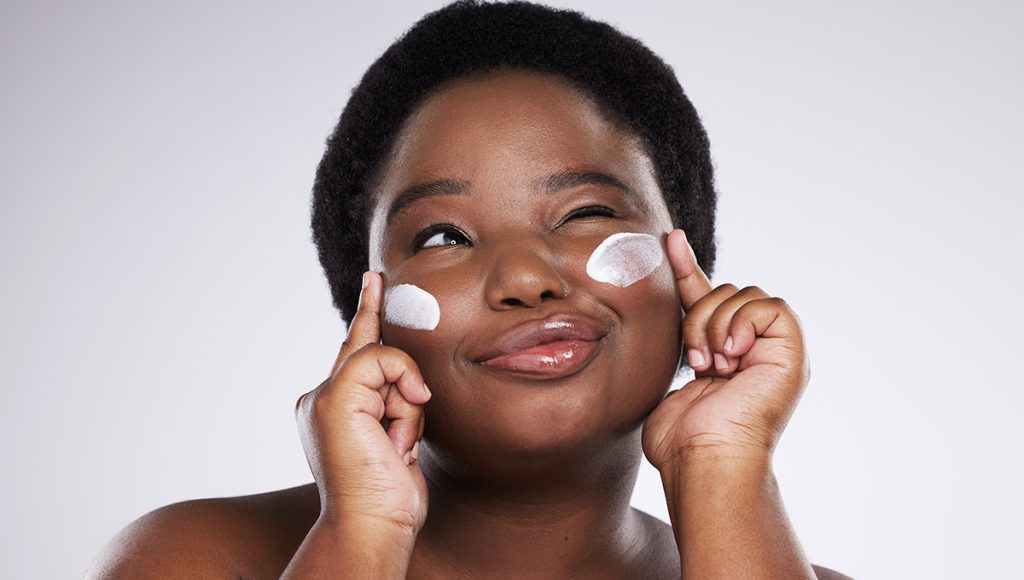
Short hikes don’t get you to the mountain top. Long-term routines? Now that’s where skin magic lives ✨.
Is It Safe Long-Term?
Absolutely. One of azelaic acid’s best features is its gentleness over time. Unlike hydroquinone, it’s safe for continued use — even for months or years.
- Won’t thin your skin
- No rebound pigmentation
- No aging acceleration — yes, that’s a thing with harsh bleaches.
- Safe for all genders and Fitzpatrick skin types
When to Consider Taking a Break
If you experience:
- Excess flaking or peeling
- Stubborn irritation
- Breakouts ramping up
- No progress after 3 months
…it might be time to pause or reconsider your supporting products. Often, it’s another culprit rather than the azelaic acid itself.
Stay tuned into your skin, and adjust as needed.
Conclusion
Let’s bring it back full circle. Azelaic acid for melasma isn’t about quick fixes — it’s a reliable, safe, calming powerhouse that steadily helps fade what seemed unfixable.
When paired with thoughtful partners like Nasola Kojic Acid Serum, Triple Acid Pads, and the Kojic Acid Toner, you give your skin a chance to heal, glow, and yes — reclaim its even tone.
So go ahead — start that journey. Your skin’s best chapter may not have been written yet.
Frequently Asked Questions
Results typically begin to show between 4–8 weeks, with full brightening and pigmentation reduction occurring after 3 months of consistent use. Individual skin tone, severity of melasma, and use of supporting products can influence effectiveness.
Yes! This pair works synergistically to inhibit melanin production and slow down the appearance of dark patches. Try layering azelaic acid with the Nasola Kojic Acid Serum for controlled and noticeable brightening.
OTC versions are usually at 10%, which are effective with consistent use. Prescription options range from 15–20% and may show faster results. Pairing them with kojic acid boosts efficacy.
Yes, but gently! Use exfoliants like Nasola Triple Acid Pads or Lemon Turmeric Kojic Pads 1–3 times/week to promote quicker turnover.
It can return due to hormonal shifts or sun exposure if not managed properly. Long-term use of azelaic acid, regular sunscreen, and maintenance with Nasola Kojic Acid products can help manage recurrence effectively.

